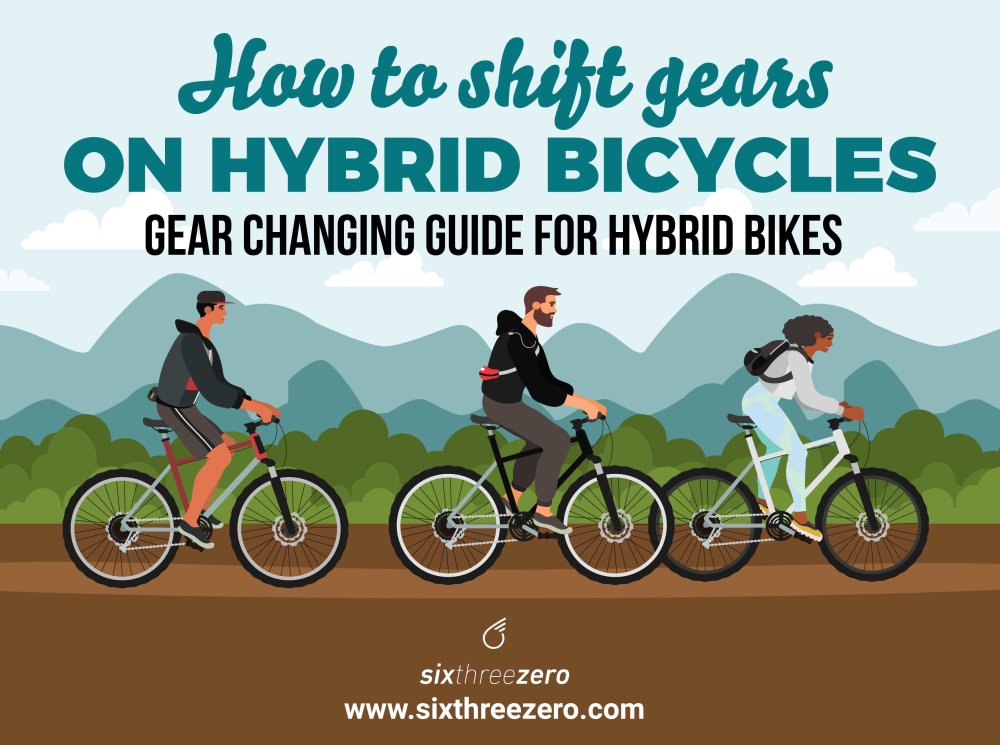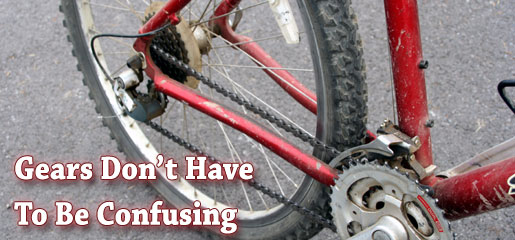Changing gears on a hybrid bike involves using the gear shifters to select different gear ratios, allowing you to adjust your pedaling effort and optimize your cycling experience.
Gears on a hybrid bike allow you to adapt to varying terrains and riding conditions. By understanding how to change gears effectively, you can maintain a comfortable cadence and improve your overall cycling efficiency.
Changing gears effectively on a hybrid bike is crucial for maintaining a comfortable pedaling cadence and optimizing your energy expenditure.
By shifting to the appropriate gear ratio, you can tackle different terrains with ease, whether it’s climbing steep hills or riding on flat roads.

I. Introduction
Importance of gears on a hybrid bike
Gears are an important aspect of any hybrid bike. They allow riders to adapt to varying terrains, levels of incline, and wind conditions. Hybrid bikes come with different types of gears, including single-speed, internal, and derailleur gears.
Choosing the right number of gears that work best for the rider’s needs is crucial as it affects the ease with which the bike can be ridden. Understanding the different gear shifting systems and using the right shifters for each brand is also important for a smooth riding experience. It is important to master the technique of gear shifting on a hybrid bike to make the most of its versatility.
Practice and experimentation with gear combinations can be instrumental in improving one’s riding skills. By learning how to change gears effectively, hybrid bike riders can enjoy a comfortable and safe ride, and make the most of their versatile bike.
Brief history of bike gears
Bike gears have been around for quite some time, dating back to the late 1800s when they were first patented in France. Initially, bike gears were used primarily to make cycling easier for riders, especially when navigating hilly terrain. At the time, the gears were located in the rear wheel hub and were activated using a lever.
Over time, bike gears have evolved, and today, there are many different types of gears available, including internal, derailleur, and single speed. In recent years, electronic shifting systems have also entered the market, adding another layer of complexity and customization to this age-old technology.
With so many variations available, it’s important to understand the history of bike gears and how they have developed into the complex systems we use today. Being able to shift gears effectively is a crucial skill for any cyclist, and by understanding the history and evolution of bike gears, we can appreciate the technology and methodology that goes into these systems, making us better riders overall.

II. Why gears matter
Overview of different terrains and riding conditions
It’s important to consider the different terrains and riding conditions you’ll be facing when selecting the right gears for your hybrid bike. Riding on flat land with just one or a few gears may be fine if you’re just going for casual rides, but hills and mountainous rides can demand all the gears you can get.
Wind and rain can also impact how hard or easy your ride will be, so having easy gears allows you to power through a headwind, while faster gears let you take advantage of a tailwind. On the other hand, rain, sleet, and snow can all slow you down, so it’s important to have the option to downshift if you’re riding in those conditions.
Understanding the right amount of gears to have for your particular needs and terrain will make your rides more enjoyable and ensure your bike is prepared for any challenge that comes its way.
Importance of having the right amount of gears
Having the right amount of gears on your hybrid bike is crucial to achieving an enjoyable and comfortable ride. Whether you are commuting to work, going for a leisurely ride, or tackling tough terrain, having the appropriate gears is important.
If you are riding on flat land, you may be able to get by with just one or a few gears, but hills require more gears. Mountainous rides and long distances can demand all the gears you can get. Weather plays a significant role, too.
Wind and rain can impact how hard or easy your ride will be, and having the option to downshift if you ride in those weather conditions is important. With the right setup, you will also be able to set your preferred pedaling cadence independently of wheels and speed, allowing you to go wherever the road or trail takes you.
Therefore, when looking into getting a hybrid bike, the number of gears should be one of the major factors in your decision-making process.

III. Types of gears for hybrid bikes
Single speed
Single speed bikes may seem like a simple option for cycling, but they can actually be quite versatile. They are particularly well-suited for casual riding on flat paths such as beach cruisers, and are great for those who want to keep their gear maintenance to a minimum.
The minimal equipment on a single speed requires very little maintenance, with just a little oil on the chain every month or so. While single speed bikes may be limited in their speed and range, they can still be an enjoyable and efficient option for many riders.
Plus, with fewer gears to worry about, single speed bikes can give you a more direct connection to the road, allowing you to focus on the experience of the ride itself. So, if you’re looking for a simple and carefree option for your next ride, consider a single speed bike.
Internal gears
Internal gears are a great option for hybrid bikes, especially for those who prefer low maintenance and easy handling. Unlike derailleur gears, internal gears are located inside the hub of the back wheel. This means that they are much more protected from dirt and grime, which results in a longer lifespan and smoother shifting.
Additionally, internal gears are known for their ability to shift while the bike is stationary, which is highly useful for commuters stuck in traffic. With internal gears, you usually have a limited range of gears to choose from, typically in the range of 3 to 14. Despite this limitation, internal gears are still a great choice for a reliable and efficient hybrid bike.
Understanding your riding needs and terrain can help you decide whether internal gears are right for you. For an easier, low-maintenance ride, they may be the best option.

Derailleur gears
Derailleur gears are a popular choice for hybrid bikes because they offer a wider range of gear options compared to single speed or internal gear systems. They work by physically moving the chain from one cog to another on the rear wheel with the use of an external component called the derailleur.
This type of gear system allows for quick and precise gear changes, making it ideal for riding in varying terrains and conditions. However, it’s important to note that derailleur systems require more attention and maintenance compared to internal gears. It’s crucial to keep the derailleur well lubricated and adjusted to ensure smooth shifting.
Plus, mastering the gear shifters on a derailleur system takes some practice and patience. With the right amount of care and understanding, derailleur gears can greatly enhance your biking experience and give you the freedom to conquer any route with ease.

IV. How to change gears on a hybrid bike
Understanding the gear shifters
Understanding the gear shifters on a hybrid bike can take some time and practice, but it’s an essential skill for getting the most out of your ride. There are two main types of gear shifters: thumb triggers and grip shifters. Thumb triggers are commonly found on mountain bikes and hybrids with flat handlebars.
They allow the rider to shift gears by pushing a lever with their thumb. Grip shifters, on the other hand, are commonly found on hybrids with curved handlebars. They work by twisting the handlebar grip to change gears. Whichever type of shifter you have, it’s important to understand which direction to move it to change gears effectively.
In general, shifting to a smaller gear (higher cadence) makes pedaling easier, while shifting to a larger gear (lower cadence) offers more power for hills or sprinting. Don’t be afraid to experiment with different gear combinations to find what works best for you and your riding style. Remember, mastering gear shifting is essential to getting the most out of your hybrid bike.
Thumb triggers vs grip shifters
When it comes to changing gears, there are two main types of shifters to choose from: thumb triggers and grip shifters. Thumb triggers are commonly found on higher-end mountain bikes and are operated by pressing a lever with your thumb to move the chain up or down the cassette.
On the other hand, grip shifters are often found on hybrid and kids’ bikes and consist of a twisting mechanism integrated into the handlebar grip. While both types of shifters have their own advantages and disadvantages, it ultimately comes down to personal preference.
Thumb triggers are known for their precise shifting and are easier to control when wearing gloves, while grip shifters offer a more intuitive and ergonomic design. Whichever type of shifter you choose, it’s important to make sure you’re comfortable with how it operates so you can make quick and efficient gear changes while out on your hybrid bike.

Proper pedaling cadence
Proper pedaling cadence is crucial to fully utilizing your hybrid bike’s gears. It is the rate at which you pedal – measured in revolutions per minute (RPM) – that determines how comfortable and efficient your ride is. Pedaling at a slow cadence while in a high gear can cause a strain on your knees and makes the ride harder than it needs to be.
On the other hand, pedaling too quickly in a low gear can cause you to tire out sooner and make the ride less efficient. The ideal cadence is between 70-90 RPM.
This range allows you to maintain a comfortable pedaling rate without overexerting yourself or slowing down unnecessarily. Don’t worry if you’re not hitting this range yet, it takes practice to master proper cadence.
Try counting your RPMs while you ride and adjusting your gear accordingly. With patience and persistence, you’ll nail down proper pedaling cadence and start enjoying a smoother, more efficient ride on your hybrid bike.
Tips for anticipating gear changes
One important tip to keep in mind when changing gears on a hybrid bike is to anticipate the need to shift. Don’t wait until you’re already struggling on a hill to downshift; instead, downshift before you start the climb to ensure a smooth transition and minimal tension on the chain.
Additionally, keep an eye on the road ahead and anticipate any changes in terrain or riding conditions that may necessitate a gear change. For example, if you know you’re approaching a stoplight or a sharp turn, shift down into an easier gear beforehand to make starting up again or navigating the turn easier.
It’s also a good idea to experiment with different combinations of gears to see what works best for your riding style and preferences. By mastering the art of anticipating gear changes, you can ensure a more efficient and enjoyable ride on your hybrid bike.

V. Shimano vs SRAM
Differences in gear shifting systems
There are several differences in gear shifting systems that you should be aware of when choosing a hybrid bike. Some bikes come with internal gears, while others have derailleur gears that operate externally. Internal gears are generally easier to use and require minimal maintenance, making them a great option for casual riders.
However, if you plan on tackling hilly terrain or commuting longer distances, a derailleur gear system may be more useful as it offers a wider range of gears for different riding conditions.
Another consideration is the type of gear shifters – thumb trigger or grip shifters. Thumb triggers are usually found on mountain bikes, while grip shifters are more common on hybrid bikes with flat handlebars.
It’s important to choose a system that you’re comfortable with and can operate easily while riding. Experimenting with different gear combinations can also help you find the ideal setup for your riding style.
How to use shifters for each brand
Knowing how to use shifters is crucial for efficient gear changing on your hybrid bike. Each brand of shifters has its own unique way of operation. For Shimano road bike shifters, the inner smaller paddle should be pushed inboard to shift down the cassette into a smaller cog (a bigger/harder gear).
The brake lever, which comes with a small shift paddle, should be pushed inboard to shift up the cassette into a larger (easier/smaller) gear. For the front (left-hand) lever, pushing the inboard lever with a smaller throw will move the cage of the front derailleur inboard to prevent chain rubbing in certain gears.
On the other hand, SRAM DoubleTap shifters use a single paddle to shift both up and down. A short click will shift into a smaller cog and pushing the lever further will shift into a larger cog. By following these simple steps, riding a hybrid bike will be a breeze.
VI. Conclusion
Importance of mastering gear shifting on a hybrid bike
Mastering the art of gear shifting on a hybrid bike is an essential skill for any cyclist. Gears allow you to maintain a comfortable cadence while tackling various terrains, making your ride smoother and more enjoyable. Without proper shifting techniques, riding a hybrid bike can be a frustrating and difficult experience.
Understanding your bike’s gears and how to shift them efficiently can make all the difference in your ride quality. Moreover, knowing the right gear combination is crucial in avoiding unnecessary strain on your bike’s drivetrain and minimizing maintenance costs. With proper gear shifting, you can increase speed, tackle hills, and adjust to different riding conditions easily.
So, take the time to learn and practice shifting, experiment with different combinations, and enjoy the full benefits of your hybrid bike.
Encouragement to practice and experiment with gear combinations.
Once you understand how to change gears on your hybrid bike, it’s time to start practicing and experimenting with different gear combinations. The more you ride, the more confident you’ll become in choosing the right gears for different terrains and riding conditions.
Don’t be afraid to play around with shifting while riding uphill, downhill, or on flat roads. Notice how your pedaling cadence changes with each gear and how it affects your speed and comfort level.
Remember to also pay attention to your proper pedaling technique and cadence as you shift gears. The more you practice, the more you’ll develop a natural feel for gear shifting that will improve your overall riding experience. So get out there and have some fun with your gears!